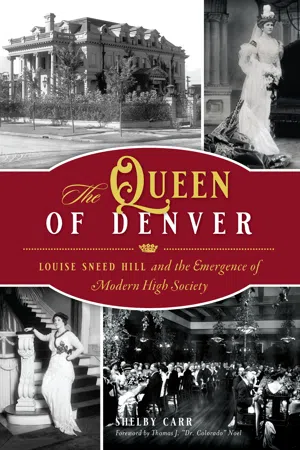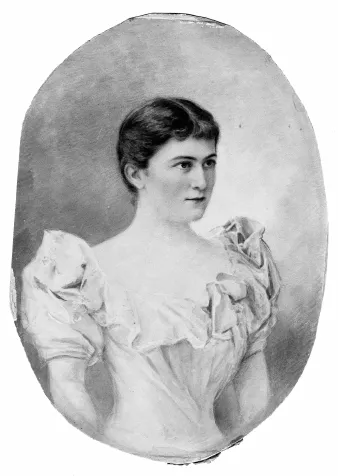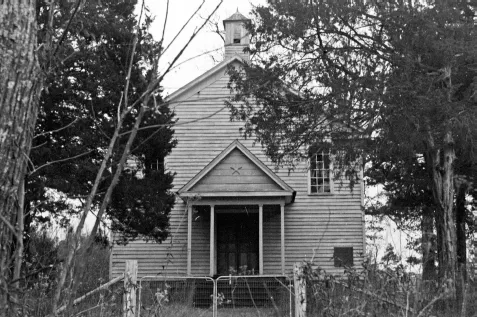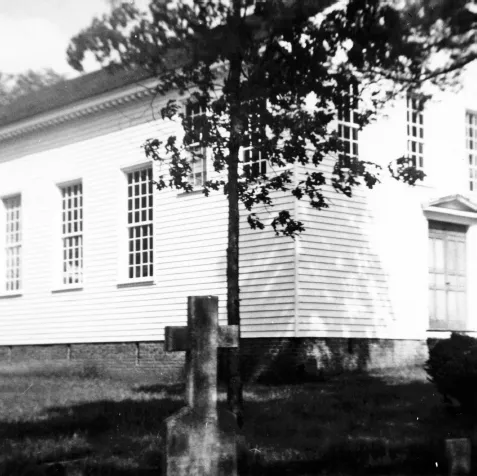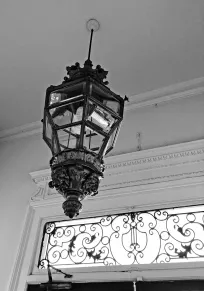![]()
1
A SOUTHERN BELLE GOES WEST
Louise Bethel Sneed was born in 1862, into the southern aristocracy. There is some dispute over the exact date of her birth. While some sources cite that her birthday is in March, a diary of her aunt (Mary Jeffreys Bethel) states Louisa “Louise” Sneed (Louise’s mother) died on July 11, 1862, “leaving an infant 11 days old.”10 An undated newspaper article—clipped and placed in a scrapbook that now resides within the larger Louise Hill Collection at History Colorado Center—entitled “Society Forecasts” claimed that Mrs. Crawford Hill was born on June 28 “in the sign of Cancer” and was “attributed with attaining remarkable prominence and power.”11 While there is no birth certificate for Louise Bethel Sneed, from the information provided, one can say with some certainty that she was born between June 28 and July 1, 1862.
Louise’s parents, William Morgan Sneed (1819–91) and Louisa “Louise” Maria Bethel (1823–62), were lifetime residents of North Carolina. Louise’s father’s side of the family first appeared in North Carolina in 1761, when Louise’s great-great-grandfather Samuel Sneed purchased a tract of land in what was then Granville County. Sometime between his arrival in the mid-eighteenth century and the turn of the nineteenth century, the Sneed family built a large plantation that was known locally as the Sneed Mansion, and the family members became prominent figures in the community.12
The plantation remained in possession of the Sneed family for generations. After many Sneeds chose to relocate to Tennessee, Kentucky and other neighboring states, the plantation in Granville County became the home of William Morgan Sneed and his family. According to the 1860 U.S. census, the Sneed property was worth about $12,920 (roughly $396,000 in today’s currency), with William Morgan’s personal estate totaling approximately $51,117 (approximately the equivalent of $1.6 million today). The Sneed Mansion was considered the “center of much gaiety, with parties, dances, horseracing, cock fighting, hunting, fishing, drinking, and gambling.” According to local history, the reputation of the mansion was “far-flung,” and when court adjourned in nearby Oxford, the common expression among the townspeople was that “court adjourned to Sneed Mansion House.”13 Williamsboro, the area in which the Sneeds resided in Granville County, was an important place in the state. It was an area that had a large tobacco industry, with plantations that grew the product and a factory that processed it. According to local historian Mark Pace, Williamsboro was even considered a potential capital city for the state. Williamsboro held an important place in the South, and as Pace noted, “there’s a reason the Sneeds were there.”14
Louise Bethel Sneed, pictured here as a young woman, grew up privileged on her family’s expansive property in Granville County, North Carolina. Courtesy of History Colorado, accession #90.314.29.
Sneed’s Mansion, pictured in 1955, is virtually unrecognizable today. Hidden by overgrowth and massive trees, the structure is currently buried deep in the woods. Courtesy of the North Carolina Room, Granville County, North Carolina Library System.
William Morgan Sneed, like his patriarchal line before him, was a slaveholder. His father, Richard, owned twenty-five slaves when he was in charge of the plantation. When Richard Sneed decided to move to Kentucky around 1850, he sold a portion of his slaves to William. William married Louisa “Louise” Maria Bethel of Caswell County, North Carolina, on June 28, 1842, and they had six children together: William Morgan Sneed Jr. (around 1843–95), Richard G. Sneed (around 1845–around 1922), Mary “Mollie” Bethel Sneed (around 1849–1933), Lucy Henderson Sneed (around 1851–1907), Walter Alves Sneed (around 1853–?) and Louise Bethel Sneed, their youngest.15
Hill’s young life appears to have been fraught with a bit of heartache. Her mother, Louisa “Louise,” passed away in July 1862, when Louise was only an infant. In fact, her mother was buried on the same day that infant Louise was baptized. A newspaper article in the Raleigh Register on July 23, 1862, stated:
Departed this life on the morning of the 11th Mrs. Louisa Sneed, wife of Maj. William M. Sneed of Granville County, N.C. and daughter of Gen. Bethel, of Caswell county, in the thirty-eighth year of her age. A devoted husband and six children, the youngest only eleven days old, have seldom had the misfortune to lament so sad a bereavement. Possessed rare personal attractions, genial in disposition, cheerful and happy, with unusual vivacity… highly educated and adorned with every Christian virtue, the subject of this brief announcement had endeared to her all who knew her.…Let all who knew her imitate her Christian forbearance and fortitude, and secure by the favor of God like her a blissful immortality in the world to come. Her remains now lie interred in the Episcopal church yard in Williamsboro, there to await the morning of the general Resurrection [sic].16
The headstone of Louise Sneed Hill’s mother reads “Louise Bethel Sneed—our mother.” It is unclear whether newspaper articles and church records of the time were incorrect in spelling her name as “Louisa.” It is possible that her headstone is incorrectly inscribed or that she was just called Louisa by those who knew her. Courtesy of Shelby Carr.
The image on the top shows how St. John’s fell into disrepair in the early nineteenth century, but it was carefully restored to its original grandeur, as depicted in the image on the bottom. Courtesy of the North Carolina Room, Granville County, North Carolina Library System.
Pictured here, in 2019, St. John’s Episcopal Church can be seen on the right, and the remains of the Sneed Mansion are located inside the mass of trees on the left side of the image. The Sneeds’ burial area (which contains the headstones of W.M. Sneed; his first wife, Louisa “Louise”; and his second wife, Sarah “Sallie” Sneed) is located on the land, in between the two structures. Courtesy of Shelby Carr.
The St. John’s Episcopal Church register for 1862 lists that infant “Lou Bethel” was baptized to parent “Wm Sneed” on July 12. The register also lists “Mrs. Louisa Sneed” as a burial for that day. Although the newspaper articles and the church register list Louise’s mother with the name “Louisa,” her headstone in the St. John’s cemetery is inscribed with the name “Louise.”
St. John’s Church was the chosen house of worship for the Sneed family, and it was basically located in the side yard of the Sneed’s property. The front door of the church is mere yards away from the Sneed Mansion property. The parish (also historically referred to as Nut Bush Church) was established in 1746, the initial structure was built in 1757 and the church was moved to its present location and building, about a half-mile from its original site, in 1772 or 1773. St. John’s is the oldest frame church in the state of North Carolina, and it is also one of three remaining colonial church buildings.17
Though tragedy was present in her early life, Louise’s family name provided her with a comfortable childhood, and she grew up as a southern belle in the grand home on her family’s land.
GENEALOGY OF THE SNEED FAMILY
The Sneed family was prominent in the South, and they strengthened their power through marriages that connected them to some of the most influential individuals in the South during the eighteenth and nineteenth centuries. Samuel Sneed (1723–1806), the patriarch of the North Carolina Sneed family, was originally from Virginia. Born in 1723, Sneed first served in the American Revolution as a captain and was later promoted to major. He first appeared in Granville County in 1761, when his name was listed in a deed transaction. He remained in Granville and was listed on numerous tax and deed records throughout the remainder of the eighteenth century. Samuel married Jane Dudley, also of Virginia, and they had approximately nine children together. In his will, which was dated 1800 and probated in 1806, Samuel named the executors of his estate, including his son, Stephen Sneed (1756–1821).
Stephen also served in the Revolution supposedly under famed general Daniel Morgan.18 From the time of the war until he passed away in 1821, Stephen Sneed served as the first clerk of the Court of Pleas and Quarter Sessions of Granville County. In 1779, he married Mary Williams (1761–1826) in Granville County. Stephen and Mary had approximately ten children together.19
Stephen and Mary’s son, Dr. Richard R. Sneed (1790–1861), married Lucy Henderson (1798–1868), the daughter of Leonard Henderson (a former judge of the superior and supreme court), in 1814.20 Leonard was the son of the famed Judge Richard Henderson, a colonial judge who was born in Virginia and who was owner of the Ashland Plantation (the oldest home in Vance County).21 Richard Henderson was also the cousin of William Williams (the father of Mary Williams Sneed). William’s brother, Judge John Williams, owned the Montpelier Plantation in Granville County, where he operated a law school for a short time and studied with his cousin Judge Henderson.22 In 1774, Judge Henderson was interested in acquiring lands from the Cherokee tribe and consequently founded the Transylvania Company to accomplish this task—an entity that both of his cousins invested in. The Transylvania Company hired Daniel Boone to explore the area they hoped to purchase; the trail Boone blazed, the Wilderness Road, “became the main route to the new settlements.”23 The company took possession of the Native American lands in 1775 and founded what would become the state of Kentucky. Though the governors of North Carolina, Virginia and Tennessee declared that Henderson’s purchase was illegal, they all subsequently granted the company about two hundred thousand acres in lieu of their agreement with the Cherokee. Henderson subsequently set up a land office to deed and sell the lands to settlers.24
Dr. Richard Sneed was a physician who was “respected by all and beloved by those with whom he was brought into professional contact.”25 He and his wife, Lucy, had ten children, and their eldest was son William Morgan Sneed, the father of Louise Sneed Hill. The future Mrs. Hill grew up privileged and well connected. She spent many summer seasons with distant relatives and close family friends Mrs. Varina Howell Davis (the second wife of the president of the Confederate States) and Mrs. Worthington Davis (the cousin of Jefferson Davis and the mother-in-law of Joseph Pulitzer, the creator of the Pulitzer Prize) at the St. Elmo in Green Cove Springs, Florida.26
This lamp now hangs in the entry way of the Louise and Crawford Hill Mansion in Denver. It was once mistakenly reported that the lamp came from the house of Thomas Jefferson. After those who were in possession of the Hill Mansion consulted with individuals from Jefferson’s house, they found that this was not the case. Rather, it is probable that the lamp (if of any notoriety) came from one of Jefferson Davis’s homes, due to Louise Hill’s familial relation to the Davis family. Courtesy of Shelby Carr.
In 1875, Miss Varina Anne “Winnie” Davis (her name was published incorrectly in local newspaper articles as “Minnie” Davis), the daughter of “Great Jeff” Davis, visited the Sneeds and stayed with them at their Granville County home. According to newspaper articles from September 1875, Winnie, “a fresh and handsome young lassie,” was “on a visit to the family of Major Sneed” and had traveled from Memphis with “a nephew and niece of Mr. Sneed.”27 An article in the Tribune of Henderson, North Carolina, discussed what a major event Miss Davis’s visit was. Their “village,” as the author wrote, due to its “remoteness from rail roads [sic], seldom [had] a peep at celebrities.” The author went on to state that the congregation of St. John’s Church was “on the qui vive” for Miss Davis, who they heard was in town to visit Major Sneed, though she did not attend church services.28 Winnie was the youngest child of the Davis family and was born in the White House of the Confederacy in 1864; she later became known as the “Daughter of the Confederacy.”29
Winnie’s mother, Varina, the only first lady of the Confederacy, upon her death in 1906, was further linked with the Sneed family. An article in the Rocky Mountain News stated that Mrs. Davis, the “widow of the Confederacy” was actually a distant relative of Louise Sneed Hill. In the article, Hill gave an interview stating that Mrs. Davis was a “woman of a strong and dominant personality, the kindly and wholesoul [sic] hospitality, the genuine feeling of the typical Southerner with the vivacity and energy of the North.” The article went on to state that Davis had just sp...
